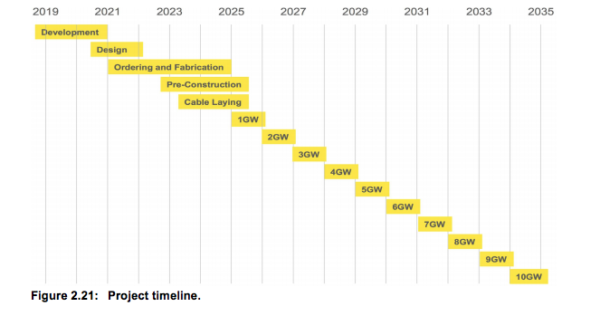The Environmental Review Document for the 11 GW Asian Renewable Energy Hub (AREH), which describes the proposed solar+wind hybrid project in north-west Australia and its likely effects on the environment, has been made available for public comment. The review period will last six weeks and close on June 24 this year.
The mega project, which has been in the planning stages since 2014, was unveiled in 2017 as a 6 GW hybrid plant. Since then, the project’s generation capacity was scaled up to 9 GW and finally to 11 GW in October last year. AREH was originally conceived to export renewable electricity to Jacarta and Singapore via subsea high voltage DC cables, but over time its focus has shifted to domestic industry consumers, with more than a half of its output allocated for existing and new energy users in the Pilbara region. This includes mines, mineral processing and anticipated large scale production of green hydrogen for local and export markets.
AREH is now looking to build more than 7.5 GW of wind turbines, and more than 3.5 GW of solar PV arrays, which together will generate more than 55 TWh hours of competitively-priced clean energy per annum over the 50-year life of the project. The wind turbines and solar panels are planned to be replaced halfway through the project’s life. It will also incorporate up to 800 MW/1 GWh battery unit to help manage power quality.
The project proponent is Adelaide-based consortium NW Interconnected Power, which comprises Australian renewables developer CWP Energy Asia, privately-owned developer of RE hubs Intercontinental Energy, Danish wind turbine giant Vestas and global investment banking and diversified financial services group Macquarie. This makes it clear that Vestas has been confirmed for the wind energy side of the project, while the search for a solar partner is still ongoing.
What is confusing is the capacity of the solar PV arrays to be installed as part of AREH. Namely, the last update from the project partners and the project website state 3.5 GW, while the Environment Review Document states 2 GW. According to the document, the project will feature “2,000 MW worth of solar PV capacity that will be divided into 37 x 55 MW modules, each of which will be up to 180 ha in size, with each module placed adjacent to a step-up substation.” pv magazine has reached out to AREH team and will update this article as soon as we receive an answer.
In terms of solar array installation, the document notes that the PV panels will be mounted on low impact steel frames with single axis tracking, adding that at each array there will be up to 37 inverters and up to 10 MW in lithium-ion batteries.
The Environmental Review Document also states that the project will be divided into two phases: a “Pilbara phase”, which will dedicate energy for large energy users in the Pilbara region, including for green hydrogen production; and a “Cable Export phase”, which will dedicate generation for export to Jakarta and Singapore. It goes on to state that “all 15 GW of generation required for the two phases will be undertaken by wind turbines and solar arrays within the same development envelope”, which is also different from the project website and the previously announced 11 GW of renewable energy capacities.
Potential impacts and perks
A total of 11,962 ha of vegetation will be permanently cleared, representing 1.81% of the development envelope of 662,400 ha. On top of that, up to 1,514 km of site access tracks will be constructed, linking the project infrastructure. The project will also involve deployment of four HVDC converter stations (at the site, at either Port Hedland or Dampier, at Jakarta, and at Singapore) and 800 kV subsea export cables (4 x 3,500 km) and up to 37 substations.
AREH is expected to create a significant number of jobs in the Pilbara and Kimberley regions, including around 3,000 new full time jobs during the 10 year construction period and around 400 ongoing jobs during the 50+ year operational life of the project.
Should it get an environmental nod from the state of Western Australia, AREH is forecast to reach financial close in 2021. Construction at the site will only start by 2024/25.

This content is protected by copyright and may not be reused. If you want to cooperate with us and would like to reuse some of our content, please contact: editors@pv-magazine.com.









1 comment
By submitting this form you agree to pv magazine using your data for the purposes of publishing your comment.
Your personal data will only be disclosed or otherwise transmitted to third parties for the purposes of spam filtering or if this is necessary for technical maintenance of the website. Any other transfer to third parties will not take place unless this is justified on the basis of applicable data protection regulations or if pv magazine is legally obliged to do so.
You may revoke this consent at any time with effect for the future, in which case your personal data will be deleted immediately. Otherwise, your data will be deleted if pv magazine has processed your request or the purpose of data storage is fulfilled.
Further information on data privacy can be found in our Data Protection Policy.